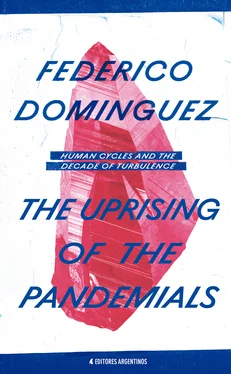Why are universities so expensive in the United States? For a host of factors, including limited spots in Ivy League universities in a context of a growing population and a high influx of international students, high salaries for professors who give few hours of weekly lectures, and the high cost of upkeep of their enormous campuses. On the other hand, given than young people acquire debt in order to study and that these loans are guaranteed by the federal government, universities are hardly concerned about costs. This is just another example of a market distortion created by federal government policies. In contrast, European universities are cheaper thanks to more frugal, urban buildings and professors who give more hours of class per week.
There are three problems with the university system. The first is that due to its cost, in many countries, access to the best universities has become a privilege for the rich. According to a study done by The Equality of Opportunity Project, the best American universities (Ivy League institutions like Columbia, Yale, and Harvard) have a higher number of students from families from with top 1% in terms of income than from those from the bottom 60%. (55)
Several factors contribute to this concentration, ranging from their high tuitions to the fact that the admissions system tends to favor the rich because they have more resources to prepare themselves, as well as extracurricular credentials such as internships and volunteer programs. On the other hand, although the last decades have seen an increase in the number of young people who attend university from diverse social backgrounds, there has not been an increase in the number of graduates raised in middle-income and lower-income families. Many of those who are unable to finish university end up with the crippling combination of student debt and no degree. In contrast, the number of university graduates from high-income families has increased considerably.
The second issue with university education is that it is not training enough scientists, mathematicians, nurses, engineers, IT specialists, software developers, therapists, and social workers. All of these professions are in high demand and will be very necessary during the Fourth Industrial Revolution.
The third problem is that companies struggle to hire people trained outside of the traditional university system. There is a bias that assumes that a university education is the only guarantee of quality professional training. However, there are people trained through apprenticeship systems or by doing several short programs and staggering studies with work experience who turn out to be excellent professionals.
According to the OECD, in 2018, 32.3% of young people in Germany between the ages of 25 and 34 had completed university education, opposed to 47% in France and 50% in the US. Germany, however, has one of the most successful job placement systems in the world known as the dual system of vocational training. In this system, people receive training both at learning centers as well as at a company, which allows students to learn as they work. Many young people are later hired by the same company where they were trained. Thanks to this, Germany’s rate of unemployment in young people dropped to under 5.6%, compared to 21% in France and 33% in Spain. (56) This model is gaining popularity among Democrats in the United States (57) and politicians in other parts of the world.
Reassessing the university model, its costs, and the professionals we are training is crucial if we want to recover meritocracy, motivate young people, reduce social unrest, reintegrate those neglected by technological change, and prepare the world for the possibilities of a Fourth Industrial Revolution.
But the entire university model just discussed does not work if it is not preceded by a proper primary and secondary education. In recent past decades, the public system has been lagging in terms of academic quality, which only serves to further widen the social gap. Public education –and private education to a lesser degree– has lost its ability to innovate due to teachers’ unions and governments that prevent flexibility in schools.
The alternative to the public school system is charter schools. These are learning establishments financed by the government but operated by independent entities. They receive a fixed payment per student. A good example is the Success Academy, which manages 45 schools in New York City districts. Their students academically outperform schools in the most expensive suburbs where the average income is up to six times higher than the families of students at the Success Academy. Their pupils place among the top 1% performers in math and English in the New York State ranking. (58)
Santiago Morgan, education specialist, commented on the matter: “Charter schools are on an upswing in many US states. They are frequently at the center of debates between unions, families, political parties, and the state. Very few people are indifferent over the advance of this model. Any politician running for office has an informed and public opinion on the matter. Basically, they work as privately run schools with state funding. They are not private schools because they don’t charge a fee and are open to the public. In fact, most of their students belong to low-income sectors. But they are not public either. They follow far fewer regulations, are not held accountable in the same way as their public counterparts, and most importantly, the employment relationships they establish with their teachers are a lot more flexible than in public schools (hence the trouble spot with the unions). Their success and growth are due to the excellent results they have been producing in recent years. They have demonstrated substantial improvements in these three areas: lower dropout rates, higher rates of university admission, and higher scores on standardized testing. They outrank almost all their public counterparts and, in some cases, even private ones.”
It is commendable for the state not to get involved in schools and universities because it eliminates the risk of political use and the intent to influence students’ thoughts. This is a very relevant issue mainly in countries that have experimented populist and authoritarian governments.
THE INVERTED CURVE – TAXES
The first country to introduce an income tax was the United Kingdom in 1798 as a means for financing its war against France. The United States incorporated a federal income tax in 1861 to help pay for the Civil War on a temporary basis. It was later repealed by the Supreme Court but then reintroduced in the sixteenth constitutional amendment, which authorized the federal government to collect it once again. Taxes and spending did not exceed 15%–17% of GDP in most countries until World War II. (59) By the end of the war, with the expansion of the welfare state, public spending started to grow, eventually reaching 35%–50% of GDP in most developed countries and a slightly lower level in developing countries.
In the current context of the pandemic and high rates of inequality, the discussion among many economists and politicians revolves around raising taxes on the rich, not just on income but on assets as well. NGO Tax Justice Network analyzed the effective income tax rate paid by different income groups in the United States –including income tax, consumer tax, healthcare tax and property tax– as well as the different proposals made by the main political figures. (60) Bernie Sanders proposed raising the total tax rate on the rich to 98.2%, Elizabeth Warren proposed 86.4%, Joe Biden, 30.6%, and Donald Trump argued to keep it at its current 23%. Sanders and Warren’s plans would generate a multi-million-dollar exodus, severely affecting the economy; while Biden’s proposal would be more balanced and Trump’s would simply perpetuate inequality even further.
Читать дальше







![Theresa Cheung - The Dream Dictionary from A to Z [Revised edition] - The Ultimate A–Z to Interpret the Secrets of Your Dreams](/books/692092/theresa-cheung-the-dream-dictionary-from-a-to-z-r-thumb.webp)




